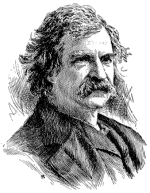The Boys’ Life of Mark Twain
by Paine

XVII. The End of Piloting
When one remembers how much Samuel Clemens loved the river, and how perfectly he seemed suited to the ease and romance of the pilot-life, one is almost tempted to regret that it should so soon have come to an end.
Those trips of early ’61, which the old note-book records, were the last he would ever make. The golden days of Mississippi steam-boating were growing few.
Nobody, however, seemed to suspect it. Even a celebrated fortune-teller in New Orleans, whom the young pilot one day consulted as to his future, did not mention the great upheaval then close at hand. She told him quite remarkable things, and gave him some excellent advice, but though this was February, 1861, she failed to make any mention of the Civil War! Yet, a month later, Abraham Lincoln was inaugurated and trouble was in the air. Then in April Fort Sumter was fired upon and the war had come.
It was a feverish time among the pilots. Some were for the Union–others would go with the Confederacy. Horace Bixby stood for the North, and in time was chief of the Union river-service. A pilot named Montgomery (Clemens had once steered for him) went with the South and by and by commanded the Confederate Mississippi fleet. In the beginning a good many were not clear as to their opinions. Living both North and South, as they did, they divided their sympathies. Samuel Clemens was thoughtful, and far from bloodthirsty. A pilothouse, so fine and showy in times of peace, seemed a poor place to be in when fighting was going on. He would consider the matter.
“I am not anxious to get up into a glass perch and be shot at by either side,” he said. “I’ll go home and reflect.”
He went up the river as a passenger on a steamer named the “Uncle Sam." Zeb Leavenworth, formerly of the “John J. Roe,” was one of the pilots, and Clemens usually stood the watch with him. At Memphis they barely escaped the blockade. At Cairo they saw soldiers drilling–troops later commanded by Grant.
The “Uncle Sam” came steaming up to St. Louis, glad to have slipped through safely. They were not quite through, however. Abreast of Jefferson Barracks they heard the boom of a cannon, and a great ring of smoke drifted in their direction. They did not recognize it as a thunderous “Halt!” and kept on. Less than a minute later, a shell exploded directly in front of the pilot-house, breaking a lot of glass and damaging the decoration. Zeb Leavenworth tumbled into a corner.
“Gee-mighty, Sam!” he said. “What do they mean by that?”
Clemens stepped from the visitors’ bench to the wheel and brought the boat around.
“I guess–they want us–to wait a minute–Zeb,” he said.
They were examined and passed. It was the last steamboat to make the trip through from New Orleans to St. Louis. Mark Twain’s pilot days were over. He would have grieved had he known this fact.
“I loved the profession far better than any I have followed since,” he long afterward declared, “and I took a measureless pride in it.”
At the time, like many others, he expected the war to be brief, and his life to be only temporarily interrupted. Within a year, certainly, he would be back in the pilot-house. Meantime the war must be settled; he would go up to Hannibal to see about it.
 Continue...
Continue...![[Buy at Amazon]](http://images.amazon.com/images/P/B0006AHKG6.01.MZZZZZZZ.jpg)